The birth and development of remembrance policy in France
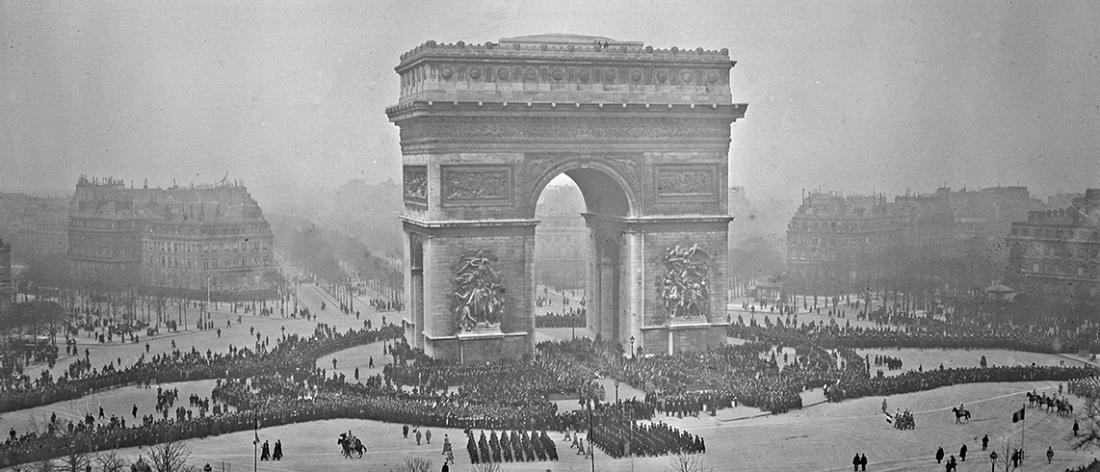
The obligation of the State to maintain the war graves of soldiers killed in combat arose immediately after the Franco-Prussian War (1870-71), the 150th anniversary of which has recently been celebrated. Since then, remembrance has continually evolved in its aims and form, in step with all the partners involved, whether public, private or voluntary.
In his famous speech of 1882, Ernest Renan pondered on the meaning of “the Nation”. This question, asked by historians today, resonates throughout society and is bound up with the complex issue of identity. For Renan, a nation was “a soul, a spiritual principle”, a “legacy of memories” and a “desire to live together”, a definition which is commonly contrasted with that of the Germanic world based on language, religion and blood. However, for that reality to become tangible and comprehensible, it must be embodied by a remembrance policy providing citizens with values and standards. Yet any remembrance policy is based on a State-led civilian ritual that “crowns and recasts the political community” (P. Ory). In France, that ritual is a commemoration, in the sense of “remembering together”, which can become a celebration, in the sense of honouring and celebrating positively. With all its stakeholders, the French Revolution made it a unique instrument of civic education, the opening article of the Constitution of 1791 stating that “public festivities shall maintain the fraternity between citizens and tie them to law and country”. Since then, that momentum has never let up, notably around Bastille Day (14 July) and the celebration of the great men, as shown by the current debates surrounding the “Haut Comité aux Célébrations Nationales”, dissolved in 2018 and replaced by France Mémoire and its “Service des Anniversaires et Commémorations Historiques”, under the aegis of the Institut de France.
But the issue becomes more complex when it involves war remembrance, especially since commemorations of conflicts account for three quarters of France’s 15 national holidays. Furthermore, French remembrance policy is largely based on the memory of the Franco-German conflicts – or at least it was, up until the 1960s. We will therefore seek to understand the origins of this peculiarity that aims to make war remembrance an instructive and exemplary civic practice. Then we will look at how it has developed and mutated in the light of Europe and the transformation of contemporary conflicts.
Commemorating a defeat: the paradox of the birth of remembrance policy
It all began with France’s bitter defeat in the Franco-Prussian War (1870-71) and the double trauma of military defeat and the collapse of the imperial regime. Until the republicans’ electoral victory in 1877, France hesitated between various regimes, all of which raised questions about its identity, memory and existence as a nation. But it was not until the Republic, and the constitutional laws of 1875, that a policy of war remembrance was set in place, designed to consolidate the nation and thoroughly “republicanise” the country.
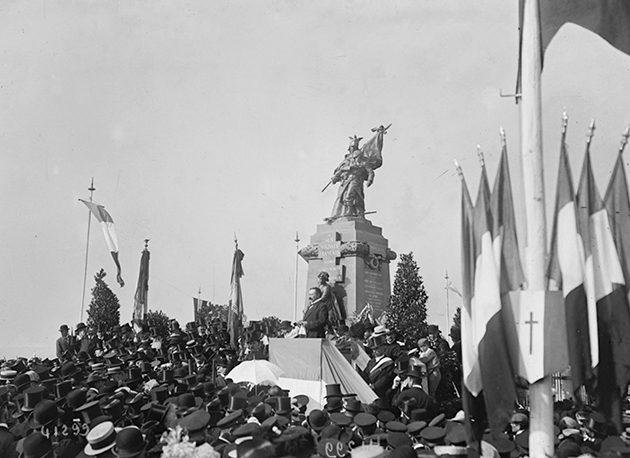
The Franco-Prussian War: inauguration of a memorial to French soldiers, under the German occupation, at Noisseville (Moselle), 1908.
© Maurice-Louis Branger/Roger-Viollet
For a long time, however, remembrance was restricted to victorious sovereigns and generals (Louis XV at Fontenoy; Desaix at Marengo), who far from embodied the nation as a whole, while ordinary soldiers were systematically forgotten about in mass graves. Although things did change with the Revolution and the Battle of Valmy, which came to represent “the nation in arms”, it was under the Second Empire that the issue of remembrance came to the fore.
The Crimean War (1853-56) saw the erection of small war memorials, particularly in the Landes, to commemorate the imperial victory. But it was the Franco-Prussian War – a proto-industrial conflict which traumatised the country with occupation, the loss of the “Lost Provinces” and a high death toll, around 140 000 – that prompted the transformation of remembrance. For the war involved the entire nation, not just the conscripted soldiers, with the phenomenon of francs-tireurs (irregulars) and volunteers. How, then, to “remember together” a defeat and “build a nation”? After a few advances, like the law of 1873 on war graves, the Third Republic chose to exploit the remembrance of this war in order to “republicanise” the country. To that end, it established a civic ritual, with its “priests” (the veterans’ associations, the League of Patriots, the State, teachers, Paul Bert’s school battalions), its “temples” (the war memorials and statues), its “cantors” (Victor Hugo, Paul Déroulède) and its “liturgy” (inaugurations of monuments, including on Bastille Day, speeches and reviews, programmes and events to celebrate battles or regiments) to embody this Revenge that only it (the Republic) could accomplish. By linking Revenge, remembrance of sacrifice, heroism, love for the motherland and Republic, the regime hoped to establish itself, while at the same time creating a virtuous, mobilising national narrative.
So the country was covered with departmental and regimental memorials to the anonymous combatants, as yet with no name plaques. And, amazingly, it was around a defeat, a necessarily glorious defeat (see Lavisse’s school history textbooks and the painting La maison de la dernière cartouche) and one which justified future sacrifice, that the population came together, while the Republic asserted itself as the only hope for recovering the lost provinces.
Each new Franco-Prussian War memorial that was unveiled became a civic lesson that “to die for one’s country was the sweetest fate” and that uniting around the regime was the only way to obtain the mythical Revenge. Schools (curricula, moral lessons, “patriotic dictations”), the State (speeches, decorations) and society continually evoked it, with children’s games (Jeu d’Assaut), veterans’ associations (La Patriote, Vercingétorix), Le Souvenir Français founded in 1887, the nationalist press (Le Gaulois), revenge songs (Déroulède’s Le Clairon), the Franco-Prussian War medal created in 1911 and popular culture (Villemer’s songs, Épinal prints). A remembrance practice became established around war memorial unveilings and regimental commemorations, which drew in ever increasing crowds. The ritual was well oiled with a morning of official events, anthems dating back to the Revolution (La Marseillaise, Le Chant du Départ), the presence of the Church, bugle calls, official speeches and banquets, and in the afternoon, processions of veterans, laying of wreaths, parades and reviews, even fireworks and lights, sometimes games, and always tricolour flags. Meanwhile, the memorials inaugurated a symbolism and archetypes (the “Moblots”, the weeping mother, the child/future, the imperial eagle being trampled, the weapons) that announced those of the conflicts to come. In the words of one Marseille general, at the unveiling of the monument to Revenge, in 1900: “You will bring your children as if on pilgrimage to this masterpiece. [...] This is how we prepare young hearts [...] for the supreme hour” of civic and patriotic reconquest. The First World War and the devotion of the poilus proved by contradiction the sheer strength of this patriotic feeling forged by the commemorations and republican remembrance policy.
The stimulus of 11 November: the consolidation of a meaningful remembrance ritual
The victory of 1918 dealt a new hand for commemorative policy in general, and for that of war remembrance in particular. The commemorative calendar illustrates the vividness of the last conflict since, even before the creation of Armistice Day, the Republic established in 1920 a second official celebration in addition to Bastille Day: the National Day of Joan of Arc and Patriotism, embodied by Jules Michelet’s “Sainte de la Patrie” and designed to reconcile State and Church in a glorious act of combatant remembrance.
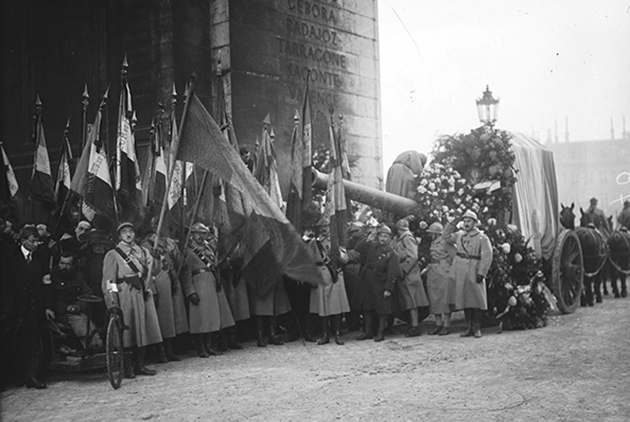
The coffin of the Unknown Soldier raised on a 155 mm gun beneath the Arc de Triomphe, during the commemorations of 11 November 1920 in Paris.
© Excelsior-L’Équipe/Roger-Viollet
For war and victory had become an obsession for a country bled dry, where a fifth of soldiers had died or gone missing and a quarter of school leavers from 1914 had died in the fighting. As Clemenceau said when he announced the victory to Parliament: “We give them [our dead] thanks; neither they, nor their families shall be forgotten and, if it is within my power, I shall see that a day of remembrance is established in their honour in the French Republic.” Over the next four years, France tore itself apart over the date on which to commemorate the Great War, not without assembling the necessary tools for maintaining a specific war remembrance.
That remembrance was initiated by the veterans’ associations, who took over from those of the Franco-Prussian War. They emerged very early on, at the height of the conflict, in 1915, with the Association Générale des Mutilés de la Guerre, before blossoming across the country and holding a congress in 1917 in Paris. Representing all social classes, regions, religions and political persuasions (from the communist-leaning ARAC to the right-wing UNC), they were awarded charitable status and had some three million members by the 1920s. They were the first to preserve the memory of the Great War and became a powerful lobby, which pushed for the creation of a national day in honour of the sacrifice and memory of all the soldiers who fought in it, often referred to as “comrades”. This was not quite what the State had in mind. Instead, it created the awards necessary for a more positive, demonstrative, traditional cult of remembrance of the victory. To that end, it introduced the Croix de Guerre (1915), the new wording “Died for France” (1915, then 1916), the Médaille Commémorative de la Guerre (1920) and, of course, the Flame of the Unknown Soldier at the Arc de Triomphe (1920 and 1923). All these things embodied the traditional idea of a commemoration extolling a triumphant Republic as much as, if not more than, the sacrificed soldiers.
The bemedalled veterans gathered before the 36 000 municipal war memorials, now bearing the names of the dead, which covered the country in five years and were four times more numerous if one included the religious, administrative, professional, voluntary and school monuments. The war memorials took up some of the imagery of the Franco-Prussian War, with the poilu in place of the moblot, often with the Gallic cockerel, the vanquished eagle, the Marianne, and the child and/or mother in tears (see the Lodève memorial, by former stretcher-bearer Paul Dardé), and no longer with a vengeful spirit. Dedicated “To our children, who died for France” and often tragic (see Landowski’s Les Fantômes on the Butte de Chalmont), they became a daily reminder of the war, visible to everyone. Honoured at their inauguration, they were the epicentre of Armistice Day, a “commemoration of victory and peace” established as a national holiday in October 1922.
The Armistice Day ceremony at the Arc de Triomphe, 11 November 1923. © Agence Rol/BNF
Around them a civic ritual arose, with a minute’s silence (“a secularised form of prayer” – A. Prost), processions of veterans, bugle calls, readings of the names of the dead, church services in what was nevertheless a secular Republic, schoolchildren who must understand the absurdity of war, floral wreaths and civic songs. They presented a veterans’ vision of remembrance, a simple act of sacrifice and grief, a true civic lesson in hating war. The republican State vision of a more lavish and glorious celebration of victory thus gave way to quiet contemplation, with no speeches other than those of servicemen campaigning “for the commemoration of peace and not war” (Journal des Mutilés, 1922). It was no longer a question of Revenge, but of turning remembrance of the war into a tool for peacekeeping and reconciliation, including with the Germans. The whole of France was united by this new cult of remembrance, despite each political faction interpreting the former poilus’ culture of grief according to their own ideology.
It was widely propagated in schools, where Armistice Day was celebrated as much as the Bastille Day prize-givings, by teachers who had paid a high price for the war and now turned to pacificism. This painful remembrance that submerged the whole of society was also conveyed by Joan of Arc Day, but through local remembrance ceremonies (e.g. the oath of peace at Verdun, 1936), at which widows and orphans read out the roll-call of the dead. Even on Bastille Day, the associations of veterans and war-wounded were well placed to show the horror of war and how 1914-18 was the “war to end all wars”.
Everything changed with the Second World War, whose memory soon overshadowed the remembrance landscape, before the development of war and the rise to power of new generations brought about a change in French remembrance.
Development and expansion of remembrance post-1945
With the end of occupation, the issue of a new remembrance arose, while the generation of First World War veterans remained numerous. But their memory was soon eclipsed by that of the terrible Second World War, a conflict coupled with a policy of genocide, which saw the image of the Resistance fighter supplant that of the defeated soldier of 1940.
French remembrance then expanded, with new commemorations organised by new associations. In eight years, from 1946 to 1954, the cult of remembrance of the victorious Resistance was established by means of grandiose monuments (Chasseneuil-sur-Bonnieure in 1945, cascade du Bois de Boulogne in 1946, Vassieux-en-Vercors in 1948) and street names (not just Jean Moulin, de Gaulle but Casanova and Albrecht).
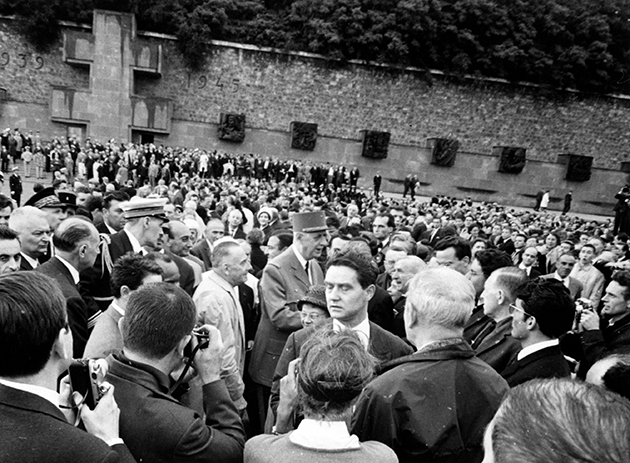
Official opening of the Memorial of Combatant France, Mont Valérien, 18 June 1960.. © Musée de l’Ordre de la Libération
At its height, this cult of the Resistance was shored up by the very Gaullist ceremony at Mont Valérien (1960), and became the positive memory of the war, to the detriment of that of the soldiers of 1940, who were deprived of monuments and simply added to those of the First World War. Backed up by school curricula that focused only on the Resistance alone and overlooked Vichy, and by many associations (e.g. the National Federation of Deported and Interned Resistance Members and Patriots, the FNDIRP) and their press (e.g. Le Patriote Résistant), not to mention the medals (Médaille de la Résistance Française, 1943), this new remembrance was topped off with the “Fête de la Victoire” on 8 May (laws of 1946, 1951,1953 and 1981), and also the “National Day of Remembrance of the Victims and Heroes of Deportation” (1954), which broadened remembrance of the Resistance to include the concentration camps.
With this surge in remembrance, the memory of the First World War has faded in spite of Armistice Day, especially with the addition, at the beginning of the 21st century, of other conflicts and defeats, namely the colonial wars lost by France (national days of remembrance of those killed in Indochina in 2005 and the Algerian War and the Maghreb, with the monument on Quai Branly in 2002 and the laws of 2003 and 2012), and above all the Jewish genocide, after President Chirac’s Vél d’Hiv speech in 1995 (the law of 2000 on remembrance of the Vichy involvement in the Holocaust, which is seeing a revival in historiography). Even so, France continues to magnify the memory of those who fought in the Resistance (National Day of 18 June in 2006 and Resistance Day in 2014), to the point where it goes on forgetting the men of June 1940, besides the heroes like de Gaulle, despite the presence of President Macron at Montcornet in 2020.
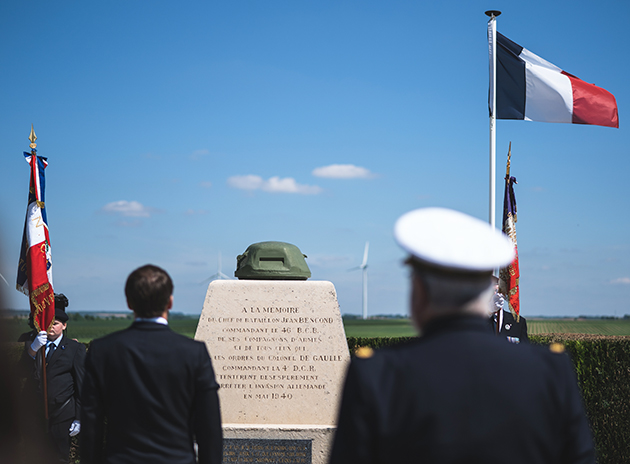
Ceremony in remembrance of the fighting of Montcornet and the Battle of France, Dizy-le-Gros and La-Ville-aux-Bois-les-Dizy, 17 May 2020, Aisne.
© Soazig de la Moissonniere/Présidence de la République
But today the issue of remembrance is even more complex. Since the end of national service in 1996, the notion of a “people in arms”, united by conscription, has become outmoded, as the nature and global context of conflicts has changed with the role of the UN. Therefore, French remembrance can only be understood in a multilateral European setting, as shown by the overhaul given to 11 November in 2012. By becoming a day of remembrance of “all those who died for France”, past, present and even future, the new anniversary of the armistice confirmed the undervaluing of remembrance of the First World War, whose veterans were now seen more as victims than as active heroes, brothers to their German comrades subjected to the same horrors. It prompted above all the emergence of remembrance of overseas operations, the only wars currently being waged by France, by a career army and no longer by armed citizens, sometimes under UN or European command, while 8 May was called into question (first by de Gaulle, then Giscard, before being made a public holiday once again by Mitterrand in 1981). A memorial to French soldiers killed in overseas operations was erected (in 2019, in Paris) to honour the new generation of service personnel and found a new remembrance, including 11 November, in which cooperation with other European countries, Germany among them, has become fundamental and changed the nature of France’s national approach to remembrance.
Inauguration of the Memorial to French soldiers killed in overseas operations by the French president, Parc André Citroën, Paris, 11 November 2019.
© Philippe Servent/Présidence de la République
In France, if remembrance policy is largely based on the commemorative remembrance of conflicts, it remains a civic educational tool for “building the nation”. Driven by the State, with support from schools, remembrance associations and orders and medals societies, it has developed considerably and practically changed in nature since it was founded following the defeat of the Franco-Prussian War, in 1871, whose remembrance united the country behind the Republic. Its rituals may in large part be founded on First World War remembrance, marked by the memory of the suffering of the poilus/heroes, but its representations (weight of the Second World War) and purposes are multiple today, because wars have changed (colonial wars, Holocaust remembrance, end of conscription), as has our view of soldiers (the poilus seen solely as victims, the role of the Resistance, new approaches to Vichy). Current French remembrance has thus become more complex and cannot be accomplished without the European Union, in which the relationship with Germany is fundamental. It continues to be a civic educational tool that structures the nation, associated today with the union of democracies and with peace in an ever more dangerous world.

